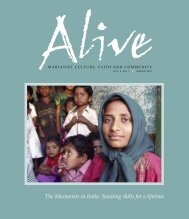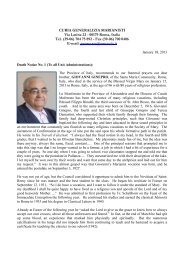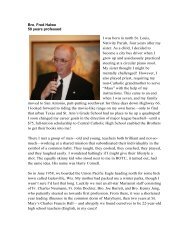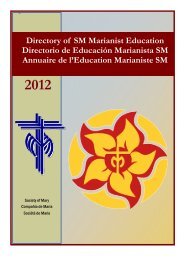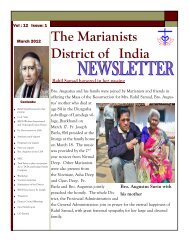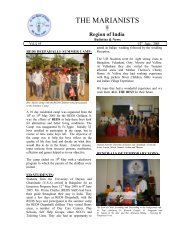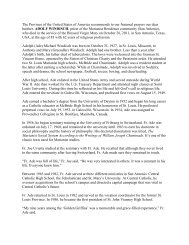thoughts about Marianist spirituality - The Marianists
thoughts about Marianist spirituality - The Marianists
thoughts about Marianist spirituality - The Marianists
You also want an ePaper? Increase the reach of your titles
YUMPU automatically turns print PDFs into web optimized ePapers that Google loves.
SETTING THE MARIANIST TABLE:<br />
A METAPHOR FOR ALL THINGS MARIANIST<br />
Presentation to the <strong>Marianist</strong> Leadership Program, St. Mary’s University<br />
September 25, 2012<br />
by Melba Fisher<br />
Partly inspired by “Things <strong>Marianist</strong>”, a publication of NACMS.<br />
Welcome: It is good that we are here. Peter’s words to the Lord at the Transfiguration.<br />
� Metaphor: from the Greek word which means to “transfer” or be a symbol of<br />
something else.<br />
� Charism: from the Greek word meaning “gift” - the Church defines charism as a<br />
gift from the Holy Spirit, which is an experience of the Holy Spirit, giving us the<br />
grace to experience the goodness of God in ways that we can live out in our<br />
lives. In a special way, by taking Mary into our lives in this uniquely <strong>Marianist</strong><br />
way, we are experiencing Jesus in His mother, we are experiencing committing<br />
our lives to her for her mission of bringing Jesus to others. That’s what grace<br />
does, and what this gift of the charism is: so that we can live so closely in union<br />
with Jesus and Mary that we experience their love and we can then give that love<br />
to others through our individual gifts and talents. We use a lot of “words” to<br />
describe the <strong>Marianist</strong> charism: family spirit, hospitality, equality, a welcoming<br />
presence, unity and union, a singular devotion to Mary as our Mother. <strong>The</strong>se<br />
are words of an experience – of grace received – which is meant to be shared<br />
with others.<br />
� What, then, is <strong>spirituality</strong>? It is the particular manner in which we live out that<br />
charism. We recognize that <strong>Marianist</strong> <strong>spirituality</strong> has at its heart a particular<br />
consecration to Mary, so that devotion to her mission, in union with her,<br />
becomes part of our <strong>spirituality</strong>.<br />
� Why do we use the term “<strong>Marianist</strong> spirit”? That’s what people often sense<br />
when they first encounter a <strong>Marianist</strong> group: it’s the spirit that emanates from<br />
them, it’s an ambience that feels welcoming and inclusive, it’s an atmosphere of<br />
congeniality, a welcoming presence, a way in which family and friends interact.<br />
[sidebar: for those of you MLP’s who recently attended the wonderful Tecaboca<br />
1
celebration, you can recall how that “spirit” pervaded the entire evening. Old<br />
friends, new friends; it was palpable].<br />
We can say that “spirit” brings to the atmosphere what we feel because it is<br />
our <strong>Marianist</strong> <strong>spirituality</strong> being lived out.<br />
� What’s in a name? Names are a symbol of a reality and are important clues to<br />
our identity: for example, Society of Mary, <strong>Marianist</strong>s, <strong>Marianist</strong> Sisters, lay<br />
<strong>Marianist</strong>s, <strong>Marianist</strong> Educational Associates, the <strong>Marianist</strong> Leadership Program,<br />
St. Mary’s University, etc. Our names have meaning, and we express that reality<br />
by the way in which we live.<br />
� So what is significant <strong>about</strong> the setting of a table? Around a table people gather<br />
to be nurtured, to celebrate each other as family and friends, to share in spirited<br />
conversations, to feel the special bond of unity as brothers and sisters in the<br />
Family of God.<br />
Here are some of the symbols we will use as we set the table – they are metaphors for<br />
who we say we are.<br />
� Notice the round table – no head place, all are welcome, all share as equals.<br />
Next time you sit at a square or rectangle table, in class, in a meeting, in the café,<br />
when you join friends for pizza, mentally change it into a round table. See how<br />
this will change your interaction with others. Jesus, at His Last Supper, reclined<br />
with his followers around a table – the word reclined implies a sense of intimate<br />
friendship. <strong>The</strong> roundness of this table implies that each voice has equal<br />
importance; whatever each person brings to the table conversation is respected<br />
and honored. <strong>The</strong> corners of a square table don’t exist as barriers or separators.<br />
<strong>Marianist</strong> <strong>spirituality</strong> is really so much <strong>about</strong> balance and transformation – just think<br />
<strong>about</strong> how a simple mental act of seeing a round table could make a huge difference in<br />
meetings! It could have a transforming effect!<br />
Thinking <strong>about</strong> the roundness of a table is also a good way to remember to include<br />
everyone in a shared conversation – those inclined to dominate a conversation will<br />
become more sensitive to that tendency; those who feel shy will be encouraged to speak<br />
what is on their minds in the atmosphere of acceptance. Why? Because when you look<br />
around a round table, you see no corners, no obstacles, no symbols of separation or<br />
division. That’s a very <strong>Marianist</strong> way of thinking <strong>about</strong> the value of each person.<br />
2
� Now comes the table cloth – it covers the utilitarian nature of the table, it dresses<br />
it up for a special occasion, it lightens and brightens the mood of the meal. I<br />
like to think, as metaphor, that the table cloth covers up the messiness of the<br />
daily use of the table, and lets us step back a little and see the tablecloth (or<br />
placemats) as preparing for a celebration. It sets a new mood as people<br />
approach the table for the meal. That’s very <strong>Marianist</strong>.<br />
� Placing flowers in the center of the table. Flowers are a visible sign of God’s<br />
creative genius. Flowers are a traditional sign of welcome and hospitality. How<br />
often we take flowers to give to another person either in a special celebration or<br />
remembrance, or as a welcoming offer of beauty. Each time we greet one<br />
another, we are “placing flowers” at the center of that moment – and that is very<br />
<strong>Marianist</strong>. <strong>The</strong> wedding feast at Cana is a family celebration involving meal,<br />
wine, sharing, very central to our <strong>Marianist</strong> charism. I like to think that Mary<br />
brought a freshly picked bouquet of wild flowers for the bride’s table on that<br />
occasion. Next time you bring flowers to your Mom or sweetheart or loved one,<br />
think <strong>about</strong> how you are honoring the center of that special person’s moment.<br />
� Now come the candles. Candles bring warmth, light, a special ambience to the<br />
event. <strong>The</strong> lighting of candles has a very Scriptural basis: an ancient tradition<br />
from our Judaic roots, carried forward as we light the altar candles before Mass<br />
or at other spiritual events. Almost every culture uses candles, and they<br />
translate into a variety of symbols for human gatherings. We use candles to<br />
remember those loved ones who are no longer with us. We use candles to<br />
comfort our spirits in moments of tragedy and sadness. We use candles when<br />
the electricity goes off!<br />
Candles often cause something else to happen: have you ever noticed how the act of<br />
lighting candles can cause a momentary pause in conversation, or bring quietness to the<br />
event? When we light candles on a birthday or anniversary cake, suddenly all eyes are<br />
on the candles and we anticipate the singing to follow. This is a reminder of our need<br />
to have moments of quietness, to ponder, to reflect, to pray, to renew our faith. That’s a<br />
very <strong>Marianist</strong> thing to do.<br />
� Setting the table with the tools/utensils needed for the meal. <strong>Marianist</strong>s model<br />
family spirit and community in a unity of persons gathered together. <strong>The</strong> meal<br />
needs tools – knives, forks, spoons. As members of a community, we recognize<br />
that people bring a wide variety of skills, talents, ideas, ways of achieving goals<br />
and objectives. Each tool or utensil has a specific role, but none is more<br />
important than the other. <strong>The</strong> knife is as essential as the fork or spoon. Try<br />
3
eating a creamy soup with your fork, or eating peas with your knife! Trying<br />
cutting brisket with your spoon! <strong>The</strong> tools or utensils make smoother the goal of<br />
the meal: to be nourished and nurtured. <strong>The</strong> tools and skills we bring to any<br />
human endeavor are designed to be interactive, to make the parts smooth out<br />
and facilitate the intended outcome. That’s why the <strong>Marianist</strong> way is to value<br />
and honor everyone’s contributions. It’s why Blessed Chaminade wanted “unity<br />
without confusion.”<br />
Note: We’ve set out the knives and forks, all matching. However, we’ve set out<br />
four different patterns for the spoons; they don’t match the set or each other. <strong>The</strong><br />
reason? That’s how we are as a people who welcome others to our table, each one<br />
unique, different, not matched sets. Yet see how beautifully these utensils blend<br />
together. <strong>The</strong>y actually add variety. And, they get the job done!<br />
� Importance of the napkin. Whether it be cloth or paper, the napkin helps us<br />
keep the messiness of life where it belongs, to wipe up spills, gather up<br />
fragments, clean up after self and others. <strong>The</strong> napkin serves as metaphor for<br />
how to serve others in a variety of ways. It’s a metaphor for servant-leadership,<br />
which is basic to <strong>Marianist</strong> life. It’s the reality of learning to be other-centered<br />
rather than self-centered. When we sit at table, it’s usually the first thing we<br />
reach for.<br />
� I’m getting hungry – bring on the plates! Dishes are the recepticles for the food<br />
we are <strong>about</strong> to receive. Dinner plates, salad bowls, serving bowls, platters,<br />
dessert dishes, cups and saucers: whatever table setting we use, the dishes<br />
remind us of the good things to come, they get our saliva juices rolling, they<br />
anticipate some really delicious food items. So often conversations begin around<br />
a particular food item. Dishes serve as a bridge to that camaraderie that happens<br />
at the table. A plate with a single slice of pizza next to a mug of cold beer is as<br />
important to human interaction as the most elegant meal at a luxury hotel. With<br />
dishes, we are served nutrition for our bodies as well as for our spirits. Next<br />
time a warm apple pie is served at your table, notice the smiles as forks dig into<br />
that luscious crust and fruit.<br />
<strong>The</strong> hospitality around a meal and at table is so much a <strong>Marianist</strong> happening! Think<br />
<strong>about</strong> that next time the Brothers host an ice-cream party at Casa Maria <strong>Marianist</strong><br />
Community, you are invited for chips & salsa at a <strong>Marianist</strong> event, you eat lunch with<br />
the brothers in the Meet the Brothers program.<br />
4
Sometimes dishes get broken. Sometimes life gets messy and complicated. Sometimes<br />
that empty soup bowl reminds us of the many people around our world, in our own<br />
country, who don’t have food to put on their dishes. Think <strong>about</strong> the kitchen cabinets<br />
that hold stacks of dishes, but the pantry and the refrigerator are near empty.<br />
<strong>The</strong>re is a very special “dish” that we see whenever we attend celebration of the<br />
Eucharist, Mass. When the priest holds up the paten before the Consecration, that<br />
paten, that dish, is a bridge that unites us to our Heavenly Father. On it is placed the<br />
food that will become the very Body and Blood, Soul and Divinity of our Lord Jesus.<br />
Celebrating the Eucharist, that is very <strong>Marianist</strong>! We come together around the table of<br />
the Lord, we set the table with altar cloth, sometimes flowers, we light the candles, we<br />
put out the dishes (the paten and chalice), and the napkin (the purificator) is placed<br />
next to the chalice. It is the heavenly banquet, the meal we share with our God and<br />
with each other. It is the Supper of the Lamb.<br />
� Water glasses, pitcher of water, perhaps the wine glasses are set out. What is<br />
the mystery of water? It has no color, shape, flavor, yet it is as essential to life as<br />
air and food. We use water to bathe and cleanse, to quench our thirst, to mix<br />
with other substances, to cook and bake, to keep flowers fresh, to water lawns<br />
and gardens. We pray for the life-giving rains in times of dryness. We like to<br />
“dance in the rain” when they finally come. Jesus spoke of the “living waters”<br />
He brings that truly quench our thirst . He asked the Canaanite woman at the<br />
well for a cup of water, having traveled far, but he used it as a means of<br />
beginning a conversation with her, of reaching out to her.<br />
Our water glasses remind us of the individual gifts that those joining us at<br />
table bring with them. You can’t wrap your fingers around the water itself,<br />
but you can wrap your fingers around the water glass, as a symbol of how<br />
you grab hold of that other person’s specialness – and celebrate it with the<br />
raising of your glass. We use glasses, whether of water or wine or other<br />
beverage, raised in unison, to celebrate, to honor, to express our admiration.<br />
<strong>Marianist</strong>s often use the raising of a glass and song to mark a special occasion at table.<br />
Ask a <strong>Marianist</strong> <strong>about</strong> a special song they sing at a celebratory event!<br />
� Wine has long been an integral part of any meal. Wine is so full of symbolism<br />
that <strong>Marianist</strong>s constantly remind us <strong>about</strong> the grape vines, the harvesting of<br />
grapes, the making of wine, the celebration of wine around special occasions, the<br />
joy of camaraderie and fellowship. Ask any <strong>Marianist</strong> <strong>about</strong> their celebration of<br />
“Gaudeamus” (let us rejoice) which is a celebration of life and unity.<br />
5
Jesus often used the symbol of the grape vine as how we are to live as<br />
brothers and sisters in the Lord, for “he is the vine, we are the branches” and we<br />
must go out and bear good fruit. Wine is the fruit of the earth and the work of human<br />
hands, as we hear each time the chalice is elevated at Mass.<br />
So, next time you enjoy or pour a glass of wine, think <strong>about</strong> its symbolism.<br />
And think <strong>about</strong> the way wine figures into the most <strong>Marianist</strong> event<br />
recalled: the wedding feast at Cana. Mary, the good Jewish and forwardthinking<br />
woman, sees the challenge of the evening: the wine has run out. She<br />
very simply tells her Son what she has noticed. <strong>The</strong>n she very simply tells the wine<br />
stewards what to do: Do whatever He tells you. Jesus comes over, the earthenware<br />
jars are filled with water, and the miracle at Cana happens. Mary’s five little words –<br />
see how they become the challenge to us today. As members of the <strong>Marianist</strong> family,<br />
that is what we are called to be and to do – to follow the Lord of our lives.<br />
� Now the bread. Whenever we pray the Our Father, we ask “give us this day our<br />
daily bread.” Bread is a sustainer of life, it is a symbol of our unity, of our<br />
membership in God’s family. Bread is essential in many good meals. Even our<br />
beloved pizza has bread as its foundation. We receive and share. Jesus chose<br />
bread as the means by which we would be fed with his Body and Blood. It is the<br />
living bread as essential as the living waters. A loaf of bread is meant to be<br />
shared, by its very nature. Often it is sliced, or in the form of rolls, ready to be<br />
passed around those at our table. It’s held in a receptacle (a platter, dish, or<br />
basket) that is symbolic of how we are to offer and share. We reach out to pass<br />
or to receive the bread. Our hands and hearts are not kept at our sides. Passing<br />
the bread is an active form of speech.<br />
� Salt and pepper, spices to ratchet up our enjoyment. Spices bring out the<br />
flavors in food. Jesus told us we are to be the salt of the earth. We are to bring<br />
flavor to the life of those with whom we interact. We are to celebrate the way in<br />
which others bring out the flavors of the human person in the setting of a<br />
community, of family spirit, of any shared project.<br />
<strong>The</strong>re is something else that spices bring to the table: many times people, often<br />
students and visitors, sense something warm and wonderful <strong>about</strong> our <strong>Marianist</strong><br />
gatherings. <strong>The</strong>y don’t always know from the beginning that it is our association with<br />
Mary that puts the spices in our lives. <strong>The</strong>y first sense hospitality, a family spirit, a<br />
sense of welcome. It’s when the light bulb in their mind lights up that they realize by<br />
our very name, <strong>Marianist</strong>s – for Mary – being Marian-centered – that is what we do for<br />
each other. We bring a special flavor, we bring out a special flavor from others, and<br />
6
share it abundantly. <strong>The</strong> salt and pepper shakers, the cinnamon and cloves, the salsa<br />
spices, get passed around the table very quickly. That is exactly what Mary did with<br />
her life: she always brought others to her Son, Jesus. She held out her newborn to the<br />
shepherds and the Magi. She kept him safe in exile in Egypt. She brought him to the<br />
temple to be consecrated to God. She helped him grow in wisdom and grace. She<br />
joined, quietly, in his mission of proclaiming the kingdom. She brought the waiters at<br />
Cana to her Son for instructions. She was there with his apostles and disciples. She was<br />
“the first disciple.” She accepted us as her sons and daughters at the foot of the cross<br />
and again at Pentecost. She is the very heart of our <strong>Marianist</strong> world.<br />
� So, what’s with the dinner bell? Many times, a dinner bell chimes to alert<br />
people that the meal is ready. Sometimes the dinner bell is someone’s voice<br />
calling out, “come and get it.” <strong>The</strong> bell is a summons to the feast. Notice at<br />
Mass, we frequently have bells ringing to announce the beginning of the<br />
Eucharistic celebration, and often bells are rung at the moment of the<br />
Consecration, summoning us to be aware of the coming of the Lord under the<br />
form of bread and wine. We are invited to come to the feast, the Supper of the<br />
Lamb.<br />
Now that the table is set, what comes next? We have set the table, we have offered a<br />
blessing prayer, we have shared the meal, we have broken bread together, we have<br />
raised our glasses in celebration.<br />
Now there are other tables to be set. Each time we come together, let us set the table –<br />
the <strong>Marianist</strong> table – whether it be with our family, special friends, in the pizza parlor<br />
or at the Mexican restaurant, enjoying a cold beer with our study buddies, enjoying<br />
popcorn at the movies, having a late-night snack.<br />
Keep the table round in your mind<br />
Remember the table cloth that covers and invites<br />
Don’t forget the flowers of remembrance and celebration<br />
Get those candles glowing – be bearers of the light in the darkness-<br />
nourish your dreams and the dreams of others<br />
If you break a dish, grab another one<br />
Use your tools to be of service to others<br />
Use your napkin to clean up the messiness of the moment<br />
Lift your glasses high with joy and respectfulness<br />
Spice up the life of others<br />
Love one another<br />
Go out and set other tables.<br />
7
A final thought: As Christians and <strong>Marianist</strong>s, we are called by our baptismal<br />
consecration and by our <strong>Marianist</strong> involvement to participate in the love of Jesus for<br />
His mother Mary. She is our mother who sends out an invitation to her children to<br />
“do whatever He tells you,” inviting us to participate in her mission of bringing<br />
Jesus to others. Blessed William Joseph Chaminade reminds us that “we are all<br />
missionaries” called to participate in Mary’s special mission. My <strong>Marianist</strong> friend<br />
in California, Bro. John Samaha, S.M., likes to remind us that “We are the lengthened<br />
shadow of Chaminade.” Let us live this in all the tables we set!<br />
8






